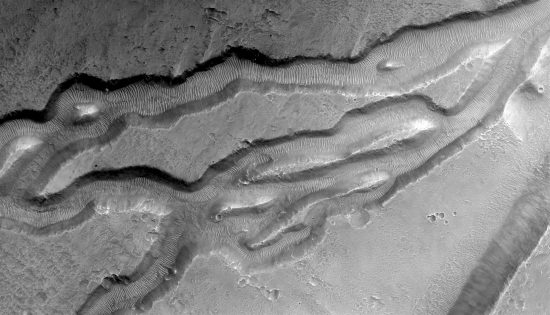Apr 7, 2017
Did water inundate Mars?
“There is a tide in the affairs of men, which, taken at the flood, leads on to fortune. We must take the current when it serves, or lose our ventures.”
—William Shakespeare
Planetary scientists believe that deep canyons, ripples, and other structures on Mars are due to water that once flowed on the surface. They think that features on Mars match those on Earth: Earth is eroded by wind and water, so, despite no wind or water processes observed on Mars today, “oceans of water” existed on Mars “billions of years ago”.
According to a recent press release, volcanoes, tectonic crustal movement, subsidence, and surface collapse in the Tharsis region released massive amounts of water from Echus Chasma, which then flooded Kasei Valles 3.5 billion years ago. The theory is based on formations that superficially appear to be water-carved.
Mars is thought to be covered with a subsurface layer of water-ice. The regolith on Mars averages about – 50 Celsius, so if water exists, it is in icy soils or underground vaults—the low-density atmosphere would cause water-ice out in the open to sublime to its vapor phase. Clouds and low-lying fog are seen in images by ground-based rovers, so the Phoenix lander was sent to investigate the northern highlands, since it is assumed that most of the remnant ice would be there. Water was supposedly detected just below the surface, but other results cast doubt on that conclusion.
Instruments on the Phoenix lander found that the soil was nonconductive, indicating no water. The Phoenix mission came to an end when it was encased by 3 meters of frozen carbon dioxide during the Martian winter. It is probable that visual cues from Phoenix indicated dry ice rather than water-ice. Dry ice melts like regular ice at – 57 Celsius if the vapor pressure at its melting point is about five atmospheres. At a vapor pressure of one atmosphere, dry ice sublimes at – 78 Celsius, which is lower than its melting point, so it changes from solid to vapor because the additional four atmospheres of pressure is missing. The lowest nighttime temperature reading is around – 80 Celsius with extremely low pressure of 8.5 millibars (Earth sea level pressure is approximately 1000 millibars).
If subsurface water formed the Kasei Valles structures, ground permeability would have to be orders of magnitude greater than on Earth, so that enough water could make it to the outflow channels. For those reasons (among others) some researchers are moving away from the water theory. Instead, lava flows from volcanic eruptions are thought to play a more significant role than previously considered.
It is possible that there are water-ice deposits on Mars. However, they most likely formed during catastrophic events that altered its surface. Plasma discharges in the form of gigantic lightning bolts left behind sinuous rilles, flat-floored craters, “railroad track” patterns in canyons (as in the image at the top of the page), intersecting gullies, and giant mesas with Lichtenberg “whiskers.”
Lightning of sufficient power can compress material in a discharge channel, accelerating it along with the negative charge, forming a jet. If the jet contains water vapor, liquid water or even ice might form inside the spinning Birkeland filament due to z-pinch effects. In an Electric Universe, it is more probable that Mars was once devastated by electricity that, among other effects, ripped out the northern terrain to a depth of six kilometers below the planet’s mean elevation.
Burned craters and piles of scorched dust lead to the conclusion that lightning thousands or millions of times more energetic than we know today resurfaced Mars. The existence of those formations constitutes a confirmation of Electric Universe theories.
Stephen Smith













